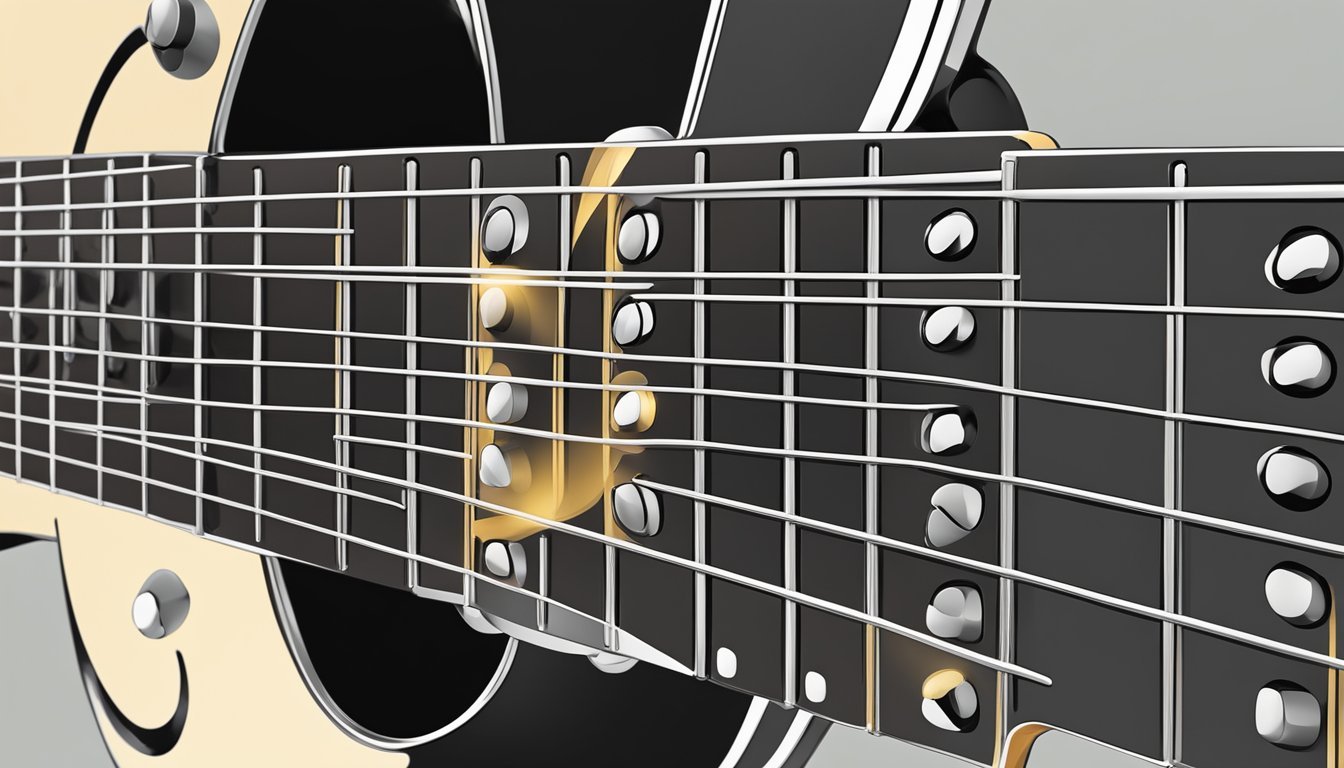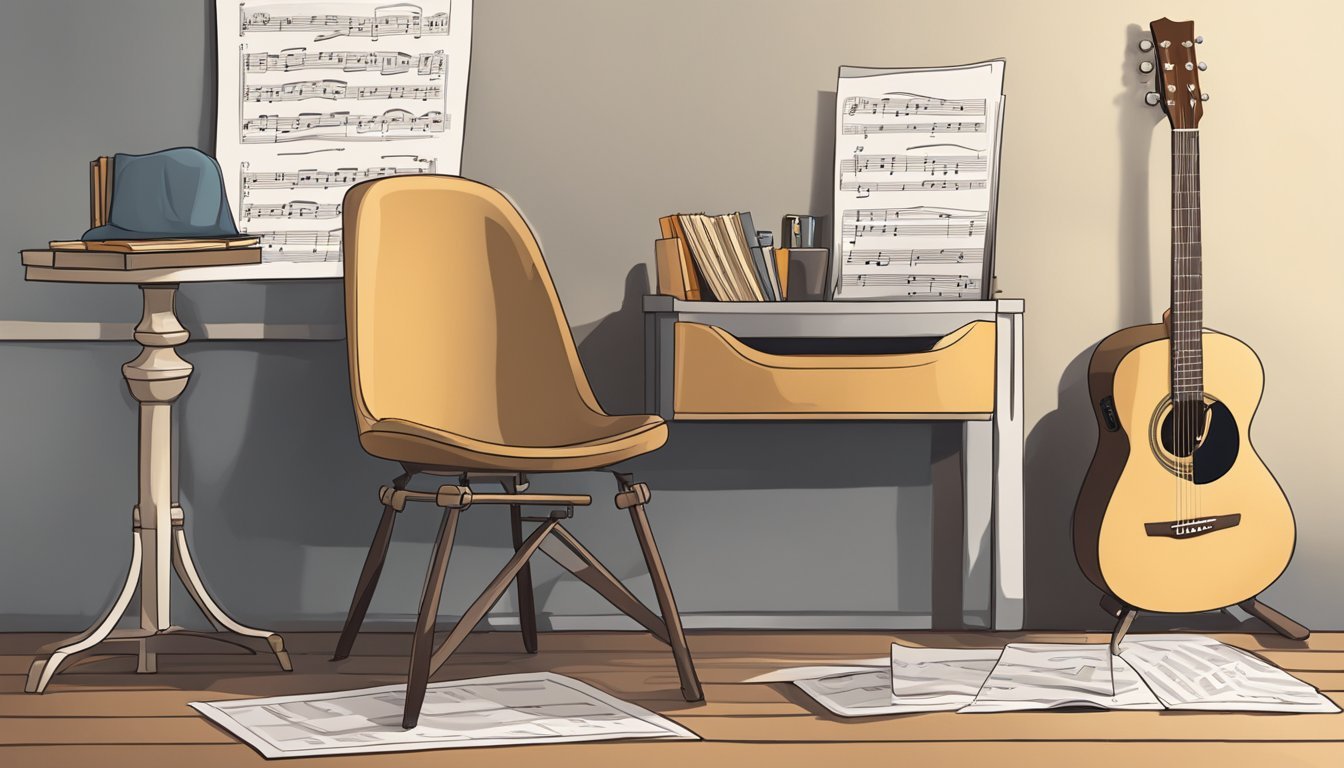Learning how to play notes on the guitar is an exciting step in your musical journey. The right techniques can help you easily identify and play notes on the fretboard, making it possible to strum along to your favorite songs. Understanding how to read guitar tabs and the note arrangement on your guitar will help you take your playing to the next level.

Getting to know the fretboard is essential for beginners.
Once you understand the standard tuning and the names of the notes, you can start recognizing how different notes form chords.
As you practice regularly, your confidence in playing notes and chords will grow, which will make playing more enjoyable.
You don’t need to be a musical genius to get started.
With consistent practice and a bit of patience, you’ll find your rhythm and become more comfortable with the guitar.
So let’s jump into the basics and unlock your potential as a guitarist!
Key Takeaways
- Understanding the fretboard is crucial for playing notes on the guitar.
- Familiarity with standard tuning helps you play more effectively.
- Regular practice will boost your confidence and skills.
Understanding the Guitar Fretboard
When learning to play guitar, knowing your fretboard is essential.
Understanding how it’s laid out helps you play notes, chords, and scales effectively.
You’ll get familiar with the guitar neck, the relationship between frets, and how notes work in different octaves.
Getting to Know Your Guitar
Start by looking at your guitar.
The fretboard is the long part of the guitar neck with metal strips called frets.
Each fret divides the neck into sections, letting you play different notes.
The open strings on a guitar are typically E, A, D, G, B, and E, from the lowest to the highest.
Memorizing these notes will help you locate other notes across the fretboard.
You might enjoy using a fretboard chart for quick reference.
Navigating Frets and Strings
Now, let’s talk about frets and strings.
Each fret raises the pitch of the note by a half step, which is also called a semitone.
For example, if you press down on the first fret of the low E string, you get an F note.
This pattern continues across the fretboard.
So, when you play the same string at the 12th fret, it plays an octave higher than the open string.
To practice, try playing a note and then moving up each fret to hear the sound change.
Notes and Octaves on the Fretboard
Understanding notes and octaves helps you play more music.
The guitar fretboard contains all the natural notes—A, B, C, D, E, F, and G. The chromatic scale includes all 12 tones, which lets you explore different notes in between.
As you play notes on different strings and frets, you’ll discover relationships between them.
For example, the note at the 5th fret of the low E string (A) and the open A string are the same note, just in different octaves.
This knowledge opens up more possibilities for playing music and creating awesome sounds!
Tuning and Standard Notation
Tuning your guitar is the first step to making music.
Understanding standard tuning and how it relates to notes will help you play more accurately and confidently.
Mastering Standard Tuning
Standard tuning is the most common way to tune your guitar.
In this setup, each of the six strings is tuned to a specific note.
From the thickest to the thinnest, the strings are tuned to E, A, D, G, B, and E.
Here’s a quick reference for the open string notes:
| String Number | Note |
|---|---|
| 6th | E |
| 5th | A |
| 4th | D |
| 3rd | G |
| 2nd | B |
| 1st | E |
Before you start playing, make sure your guitar is in standard tuning.
You can use an electronic tuner or a tuning app to help you get the right pitch.
The Relationship Between Tuning and Notes
Tuning directly affects how notes sound when you play.
Each string is set to a specific pitch, and when you fret a string, you create a note.
The note you produce will depend on both the string you play and the fret you press.
For example, if you play the 3rd fret on the 6th string, you’ll get a G note.
This relationship helps you form chords and melodies.
If your guitar is out of tune, the notes and chords can sound off, making it harder to play well.
Tuning your guitar might seem simple, but it’s essential for playing music that sounds good.
Make checking your tuning a regular part of your practice routine.
Playing Notes and Chords
Getting comfortable with playing notes and chords is essential for any guitar player.
You’ll learn how to play individual notes and put them together to create chords, plus how to transition between them smoothly.
First Steps in Guitar Notes
Start by getting familiar with the notes on your guitar.
The strings from lowest to highest are E, A, D, G, B, and E. Each fret you press raises the pitch of the note.
For example, pressing the first fret on the low E string gives you an F note.
Practice playing individual notes first.
Make sure each note rings clearly.
A big part of learning guitar is finger placement.
Always strive to press down right behind the fret to get a clear tone.
Use your fingertips to avoid muting adjacent strings.
Forming and Transitioning Between Chords
Once you’re comfortable with notes, it’s time to dive into chords.
Begin with open chords like G, C, and D. These chords use open strings, making them easier to play.
To form a chord, press down on the correct frets while strumming.
For example, the G chord requires you to press the 3rd fret on the low E string and the 2nd fret on the A string.
Transitioning between chords takes practice.
Start slow and focus on getting your fingers into position without rushing.
Try to switch between two chords, like G and C, until you can do it smoothly.
Using Chord Charts and Fretboard Maps
Chord charts are a great tool for learning.
They visually show you where to place your fingers.
For example, in a G chord chart, you’ll see numbers that represent frets and lines for the strings.
Fretboard maps also help you understand where each note is located on your guitar.
Use these maps to identify which frets correspond to each note as you practice.
By combining chord charts with your knowledge of notes, you’ll find it easier to learn new songs.
This method helps make transitions and new chords feel more natural.
Focus on consistency and practice regularly to build your confidence.
Developing Your Practice

Creating a solid practice plan is key to improving your guitar skills.
Focus on building routines and exploring scales to enhance your understanding of music theory and guitar notes.
Building a Practice Routine
Start by setting aside time each day to practice.
A routine helps you stay consistent.
Aim for about 20-30 minutes daily.
Break your practice into sections, like:
- Warm-Up (5 minutes): Begin with finger exercises to build dexterity.
- Chords (10 minutes): Focus on switching between chords. Use open chords like C, G, and D to get comfortable.
- Scales (10 minutes): Work on the major scale. This will help you learn the musical alphabet and understand semitones and intervals.
As you get comfortable, add new elements like working on a song or learning a new scale.
This balance keeps practice fun and engaging.
Expanding Your Repertoire with Scales and Exercises
Understanding scales is vital for beginner guitarists.
They are the building blocks of melodies and solos.
Start with the major scale.
It consists of whole and half steps.
Here’s how it looks in C major:
- Notes: C – D – E – F – G – A – B – C
- Sharps and Flats: Be aware of these when moving to different keys.
Use mnemonics to remember the order of notes in the musical alphabet.
Incorporate exercises like:
- Learning Finger Patterns: Practice these patterns across different scales.
- Playing Chords with Scales: Mix chords and scales. This helps you see how they connect in music.
Mixing scales with exercises boosts your overall guitar knowledge, making it easier to learn songs and improvise.
Frequently Asked Questions

Learning to play guitar can bring up a lot of questions.
Here are some common ones that beginners often ask to help you get started smoothly.
Many newcomers wonder which chords they should start with and how to develop their finger dexterity.
Choosing the right songs can make a significant difference in your practice routine, so it’s helpful to look for resources that provide easy songs for beginner guitarists.
Additionally, understanding basic strumming patterns can enhance your overall playing experience and keep you motivated as you progress.
What’s the easiest way to learn guitar notes as a beginner?
Start by focusing on the open strings of your guitar, which are E, A, D, G, B, and E. Use flashcards or apps to help you memorize these notes.
Regular practice will help you become more comfortable with identifying notes.
Can you show me how to read notes on guitar tabs?
Guitar tabs are simple to read.
Each line represents a string, with the bottom line being the thickest string (E).
The numbers tell you which fret to press down.
A “0” means play the string open, without pressing any fret.
How do I identify notes on the guitar fretboard?
Begin by learning the notes on the open strings.
Then, each fret up from a string raises the note by a half step.
For example, if you start on the open E string, the first fret is F, the second is F#, and so on.
What are the essential notes I should know when starting guitar?
Start with the open strings: E, A, D, G, B, and E. Then, learn the notes in simple chords like C, G, and D. Knowing these notes helps you play many songs easily.
Where can I find a simple guide to learn single notes on guitar?
Visit websites like Chambers Music Studio that provide straightforward guides.
These resources often include charts and tips tailored for beginners.
What’s the trick to playing chords and melody on the guitar?
Practicing playing individual notes of a chord before strumming can help.
This method helps you understand how the notes fit together.
Using fingerpicking can also allow you to play melodies while incorporating chords into your music.

